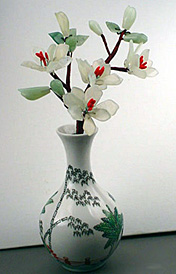
Not recognized until 1863 as two separate minerals, jadeite and nephrite: aggregate minerals that overlap in color and transparency and have been used for tools and art objects throughout history, are both called "jade". In most instances, jadeite is the more valuable member of the pair, especially in its highest quality where the price per carat can rival fine emeralds and diamonds. The granular, interlocking pattern taken by the tiny crystals in the aggregate accounts for its exceptional toughness enabling it to have been used both for tools with strength greater than most metals, and at the same time for the most delicate of carved artworks.

We usually associate jadeite with China, but that connection (which is undoubtedly major) is fairly recent. Throughout the several thousand year history of Chinese use and veneration of jade, it was nephrite which was the focus. Jadeite has supplanted nephrite in the "hearts and minds" of the Chinese in only in the last 200 years or so, since the time it first began to be imported there from Burma. Burma is still the major world source, especially for the finest material, but Guatemala, Russia, Kazakstan, Turkey and the USA (California) also contribute.



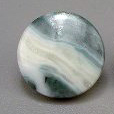
Jadeite can be semi-transparent to opaque and covers the spectrum from colorless through white, green, yellow, brown, red, orange, violet, to grey and black in color. In general, the color range and saturation values are greater than with nephrite, as is the maximum possible degree of translucency. Some of the colors are given variety, folk or trade names such as Imperial, apple green, moss-in-snow or chloromelanite. Imperial is the variety with the most highly saturated green color, apple green has some yellow, spinach green is darker and less vivid than Imperial or apple green, moss in snow has patterns in white and green, and chloromelanite is such a dark green as to appear black. Various combinations of chromium and iron are responsible for the different colors.

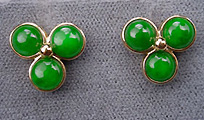
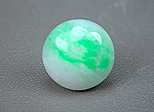
Well polished pieces have a "patent leather" shine, but considerable lapidary expertise is necessary to produce it. Jadeite sometimes frustrates lesser cutters with its tendency to undercut, which can create a dimpled or "orange peel" surface.
Virtually all of the jadeite in the mass jewelry market has been enhanced through some combination of heating, bleaching, dyeing or resin impregnation. It's generally easy to spot such treatments as the stones look too uniform and saturated in color, whereas all but the very highest grades of natural color material show some mottling of lighter and darker colors, and more or less translucent zones. Reputable vendors designate three grades of jade: "A" jade, which has had no enhancing treatment of any kind, "B" jade, which has been bleached or acid treated to remove dark spots and resin impregnated to fill the resulting voids, and "C" jade, which has been bleached, resin impregnated and dyed. It is relatively common for jadeite, even in top grades, to get a simple surface polish with a layer of colorless paraffin or beeswax.
Jadeite of inferior color is usually dyed, while that of decent color but with unattractive inclusions is subjected just to the bleaching/resin process. All the specimens of jadeite pictured in this essay are A jade. If you look around most of the mass market venues: trade shows, catalogs, home shopping channels, online auctions, etc., you will see B and C jade in abundance--> but, in fact, you will rarely, if ever, see A jade.
The ubiquitous presence of these brightly dyed and othewise enhanced jades has in some eyes diminished the beauty of the more subtle colors of natural jades, and leads some to question the much higher costs associated with the "real deal".

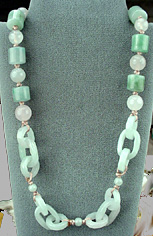
Fine chrysoprase is sometimes used as a jadeite simulant, and in its best grades has been successfully passed off as apple green, and even Imperial green jadeite. Aventurine and serpentine are also common natural simulants. An early, and still used man-made imitation of jade, is glass, which can usually be revealed by the presence of microscopic bubbles (which would never be seen in real jade). Jadeite has just recently been synthesized (by General Electric Laboratories, a leader in making synthetic gems for research), but lab created stones have not yet made an entry into the gem marketplace.

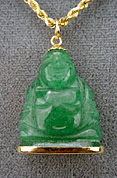
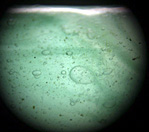
Due to its superior toughness, natural jadeite can be used for any jewelry application and needs no special care in cleaning or wearing. It can be scratched, though, by harder gems like sapphire or diamond and so, as with any fine jewelry, pieces should be given their own separate "berth" in the jewelry box. Dyed or resin impregnated pieces may fade or discolor with time.
By far, the most valuable variety of jadeite is that termed "Imperial". The finest of these gems are nearly transparent and have the most highly saturated, even, green color, rivaling (some would say surpassing) the finest emeralds. Such pieces are extremely scarce and astronomically expensive--> the name derives from the time when only the Imperial household was permitted, and could afford to own it. Among the other green colors, the next most valuable shade is termed "apple green". Fine, translucent, lavender pieces can rival good greens in price, whereas highly mottled or opaque gems are worth considerably less. Cholormelanite has some value as a scarce collector material. As with nephrite, much of the value in jadeite works of art comes from the skill with which they were carved or the antiquity of the pieces. Enhanced material is very modestly priced.